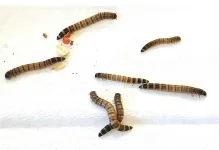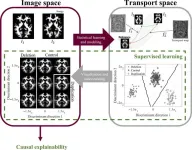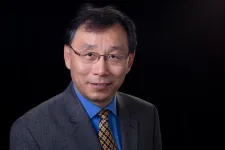(Press-News.org) Rutgers University-New Brunswick scientists have discovered a virus that caused a nationwide die-off of superworms, a common food for birds, reptiles, other pets and, more and more so, even for humans as an alternative protein source. In doing so, they pioneered a different way to search for and identify emerging viruses and pathogens in humans, plants and animals.
Using chopped up beetle carcasses forming a slurry and an electron microscope cooled by liquid nitrogen, the scientists reported today in Cell that they have discovered what they have titled Zophobas morio black wasting virus. The name is derived from the virus’ deadly effect on a species of darkling beetle, Zophobas morio, native to the subtropics, particularly in the insect’s immature larval stage when it emerges from its eggs as large, brown superworms. This species was named “superworm” because its larvae are bigger, at about 2 inches in length, than any others grown as feed.
The protein-rich larvae of Z. morio, which are dietary staples for captive, often exotic reptiles, birds, fish and amphibians worldwide, mysteriously began dying off in 2019, puzzling pet food suppliers and pet owners.
Jason Kaelber, an author of the study and an associate research professor at the Institute for Quantitative Biomedicine (IQB) at Rutgers-New Brunswick, worked with Judit Penzes, the first author of the study and a postdoctoral associate at IQB.
“Judit was looking to identify the reason beetle farmers were losing all their superworm colonies to a deadly disease and I was looking to develop ways of discovering new viruses that don’t depend on DNA or RNA sequencing,” Kaelber said. “We ended up discovering the virus that has been sweeping the country and killing superworms.”
The scientific investigation began more than a year ago, when Penzes, a molecular virologist, was contacted by beetle farm owners whose superworms were mysteriously dying off at alarming rates. Penzes was already well known in the industry because of earlier work where she isolated a virus that was killing crickets, another popular food for pets.
She started by collecting superworms at pet stores in New Jersey. “Whenever I went to a pet store, I immediately went to the feeder insect section, opened the containers and looked at the worms,” she said. “They were all infected. I told the owners of the stores what I was seeing that I was researching this virus, and asked if I could have the container. They were immediately on board. They told me to take as many as I needed.”
She returned to her lab, took a Magic Bullet blender, dropped the worm carcasses in and blended them at a high speed. The process created a slurry of beetle juice which she took and processed using a virus purification method that separates the virus out due to its density. In the final step, she shined a fluorescent light on the centrifuge tube and the virus glowed blue.
“I said, ‘I got you,’ when I saw it,” Penzes said. “I knew then it was, indeed, a virus.”
Next, Penzes worked with Kaelber, a fellow electron microscopist, to examine the virus using a cryo-electron microscope, which allows a three-dimensional view of the virus, including its interior.
“You’re taking a virus, a protein, a cell, etc., and you’re freezing it so quickly that the water solidifies without turning into ice crystals,” Kaelber said. “We actually can figure out what the amino acid sequence of the protein is without analyzing the DNA, and just by looking at that 3D structure, because we have such sharp resolution.”
They compared the structure of the protein with all known proteins using the database of the Protein Data Bank hosted at Rutgers and found that it is similar to a virus affecting cockroaches, but not identical, and part of a family of animal viruses known as parvoviruses.
“It’s a new one, different from anything that’s been sequenced or imaged before,” Penzes said.
The scientists are also grateful to superworm farmers nationwide who sent samples voluntarily, once word of the study got out. “The eagerness of the farmers to help us out researching the virus had an enormous role in helping this published study to be born,” Penzes said.
The effort, Kaelber said, provided a “proof of concept” that cryo-electron microscopy can be employed to directly discover and characterize new pathogens.
“In the future, if there’s ever a really important outbreak, we're going to want to throw every tool we can at it to see what we can find,” Kaelber said. “We’d like to make diagnostic cryo-electron microscopy routinized, so that when there’s some unknown infectious disease, we have a lot of options for same-day identification of the causative agent.”
Cryo-electron microscopy has gained popularity in recent years, becoming a more prevalent method for 3D analysis of known specimens. However, the Rutgers work represents the first time the method was used on an unknown pathogen.
After discovering the virus, the researchers tested a way to protect the Z. morio beetles from disease, by injecting a closely related virus from another species that doesn't cause symptoms. They are developing a vaccine based on that work.
“The discovery is important for two reasons,” Kaelber said. “First, beetle farmers can use this information to protect their colonies and understand which actions will be effective or ineffective at managing the epidemic. Second, the beetle epidemic was a real-world test of the technology that we hope can be useful to rapidly investigate future outbreaks in humans, plants or animals.”
Scientists Martin Holm of the Rutgers Institute for Quantitative Biomedicine and Samantha Yost of REGENXBIO Inc., in Rockville, Md., also authored the study.
END
How beetle juice led to the discovery of a virus and solved the mystery of a superworm die-off
An advanced form of microscopy and insect slurry aids Rutgers researchers in identification of pathogen
2024-08-28
ELSE PRESS RELEASES FROM THIS DATE:
Leading computational scientist & oncology researcher Elana Fertig appointed new Director of the Institute for Genome Sciences
2024-08-28
University of Maryland School of Medicine (UMSOM) Dean Mark T. Gladwin, MD, announced today the appointment of Elana J. Fertig, PhD, FAIMBE, as the new Director of the School’s Institute for Genome Sciences (IGS). She is internationally-recognized for her work in integrating spatial multi-omics technologies with mathematical models to develop a new predictive medicine paradigm in cancer. Spatial technologies allow researchers to learn about any cell type inside of natural tissue, including gene activity ...
UVA research cracks the autism code, making the neurodivergent brain visible
2024-08-28
A multi-university research team co-led by University of Virginia engineering professor Gustavo K. Rohde has developed a system that can spot genetic markers of autism in brain images with 89 to 95% accuracy.
Their findings suggest doctors may one day see, classify and treat autism and related neurological conditions with this method, without having to rely on, or wait for, behavioral cues. And that means this truly personalized medicine could result in earlier interventions.
“Autism is traditionally diagnosed behaviorally but has a strong genetic basis. A genetics-first approach could ...
Marine engineering group to award ORNL researchers for innovative welding software
2024-08-28
Zhili Feng, a distinguished R&D staff member, and Jian Chen, a senior R&D staff member, in Materials Science and Technology Division at the Department of Energy’s Oak Ridge National Laboratory, will receive the Elmer L. Hann Award at the Society of Naval Architects and Maritime Engineers, or SNAME, Convention on Oct. 15 in Norfolk, Virginia. SNAME plays a crucial role in promoting excellence in marine engineering and naval architecture, supporting professionals through education, research and collaboration.
The award is presented to authors of the best paper on ship production delivered at a SNAME event. In September 2023, Feng and Chen presented “Develop ...
UBC engineers develop all-in-one solution to catch and destroy ‘forever chemicals’
2024-08-28
Chemical engineers at the University of British Columbia have developed a new treatment that traps and treats PFAS substances—widely known as “forever chemicals”—in a single, integrated system.
Per- and polyfluoroalkyl substances (PFAS) are widely used in manufacturing consumer goods like waterproof clothing due to their resistance to heat, water and stains. However, they are also pollutants, often ending up in surface and groundwater worldwide, where they have been linked to cancer, liver damage and ...
Purdue researchers take inspiration from viruses to improve delivery of nucleic acid-based therapies to cancer cells
2024-08-28
WEST LAFAYETTE, Ind. — A researcher in Purdue University’s College of Science is developing a patent-pending platform technology that mimics the dual-layer structure of viruses to deliver nucleic acid (NA)-based therapies to targeted cancer cells.
David Thompson leads a team developing the carrier system called LENN. He is a professor in the James Tarpo Jr. and Margaret Tarpo Department of Chemistry and on the faculty of the Purdue Institute for Cancer Research and the Purdue ...
New USC research reveals untapped potential for mobilizing voters of color in battleground states
2024-08-28
With swing states playing a pivotal role in the 2024 presidential election, new reports from the Center for Inclusive Democracy (CID) at the USC Sol Price School of Public Policy have found significant voter turnout disparities between white, non-Latino voters and voters of color in all nine battleground states.
The reports highlight the persistent “voter representation gap,” where voters of color remain underrepresented at the polls, despite substantial population growth. If narrowed by November, the research concludes, this gap could significantly influence election results, particularly in swing states that had particularly close ...
The Public Health Career Explorer launches, matching health department job openings with career interests and preparation
2024-08-28
August 28, 2024-- A new, easy-to-use, evidence-based career assessment, the Public Health Career Explorer, has just launched to help job-seekers who are interested specifically in public health careers.
The Public Health Career Explorer career assessment tool, three years in the making, was developed at Columbia University Mailman School of Public Health. Using the well-researched O*Net MyNextMove assessment, Columbia Mailman School’s Heather Krasna, PhD, EdM, MS, associate dean of career and professional development painstakingly matched the Holland Codes (career interest codes) for each of the specific ...
How stigma affects Asian Americans living with hepatitis B
2024-08-28
Asian Americans comprise just 6% of the U.S. population, but they represent over 60% of Americans with hepatitis B. Hepatitis B (HBV) is a virus that infects the liver, and while some people may recover from the infection, others can go on to develop liver failure or cancer. HBV is transmitted through blood, semen or other bodily fluids, but it can also be passed from mother to child during birth, which is how the majority of Asian Americans acquire the disease.
Up until 2010, laws in China allowed for discrimination against people with HBV, barring adults from employment and keeping ...
New study: drug may stop migraines before headache starts
2024-08-28
MINNEAPOLIS – When taken at the first signs of a migraine, before headache pain begins, a drug called ubrogepant may be effective in helping people with migraine go about their daily lives with little or no symptoms, according to a new study published in the August 28, 2024, online issue of Neurology®, the medical journal of the American Academy of Neurology. The study focused on people with migraine who could tell when an attack was about to happen, due to early symptoms such as sensitivity to light and sound, fatigue, neck pain or stiffness, or dizziness.
Ubrogepant ...
Using high resolution mass spectrometry to study fuel chemistry
2024-08-28
WASHINGTON – U.S. Naval Research Laboratory researcher Mark Romanczyk, Ph.D., developed new analytical methods to rapidly analyze fuels and complex petroleum products by using high-resolution mass spectrometry.
The approaches Romanczyk utilizes enable highly detailed qualitative analysis of complex mixtures in minutes. One recent method facilitated the investigation of chemical changes that occurred in weathered crude oil in terrestrial environments. Several of the methods were recently published in the ...
LAST 30 PRESS RELEASES:
Structural findings reveal how distinct GPCR ligands create different levels of activation
Anything-goes “anyons” may be at the root of surprising quantum experiments
UC review: Maximizing workplace opportunity for veterans
From generation to complex control: Metasurfaces make perfect vortex beams "within reach"
Thin-film lithium niobate-based detector: recent advances and perspectives
Exploring why some people may tend to persistently make bad choices
How cells balance their protein levels
Nirsevimab vs RSVpreF vaccine for RSV–related hospitalization in newborns
Effectiveness and impact of maternal RSV immunization and nirsevimab on medically attended RSV in US children
AI gives scientists a boost, but at the cost of too many mediocre papers
Next-generation vision model maps tree growth at sub-meter precision
Genes aren’t destiny for inherited blindness, study shows
MIT study: High-fat diets make liver cells more likely to become cancerous
Exposure to multiple fine particulate matter components and incident depression in the US Medicare population
Risk of burdensome health care spending over time in the US
Nirsevimab against hospitalizations and emergency department visits for lower respiratory tract infection in infants
New microfluidics technology enables highly uniform DNA condensate formation
A new strategy for immune tolerance
Super Mario Bros. help fight burnout: New study links classic games to boosted happiness
Deepest gas hydrate cold seep ever discovered in the arctic: International research team unveils Freya Hydrate Mounds at 3,640 m depth.
Integrating light and structure: Smarter mapping for fragile wetland ecosystems
ACA-SIM: A robust way to decode satellite signals over complex waters
Probiotics can restore gut microbiome in breastfed infants
AI could help predict nutrition risks in ICU patients, study finds
Federal EITC has unexpected result, researchers say – it decreases domestic violence
Researchers identify gene that calms the mind and improves attention in mice
Artificial metabolism turns waste CO2 into useful chemicals
Ancient sea anemone sheds light on animal cell type evolution
Begging gene leads to drone food
How climate policies that incentivize and penalize can drive the clean energy transition
[Press-News.org] How beetle juice led to the discovery of a virus and solved the mystery of a superworm die-offAn advanced form of microscopy and insect slurry aids Rutgers researchers in identification of pathogen







